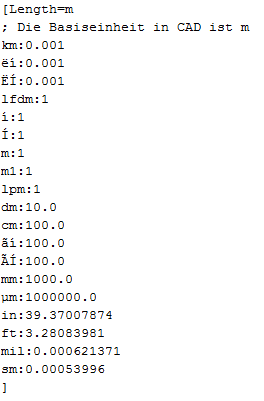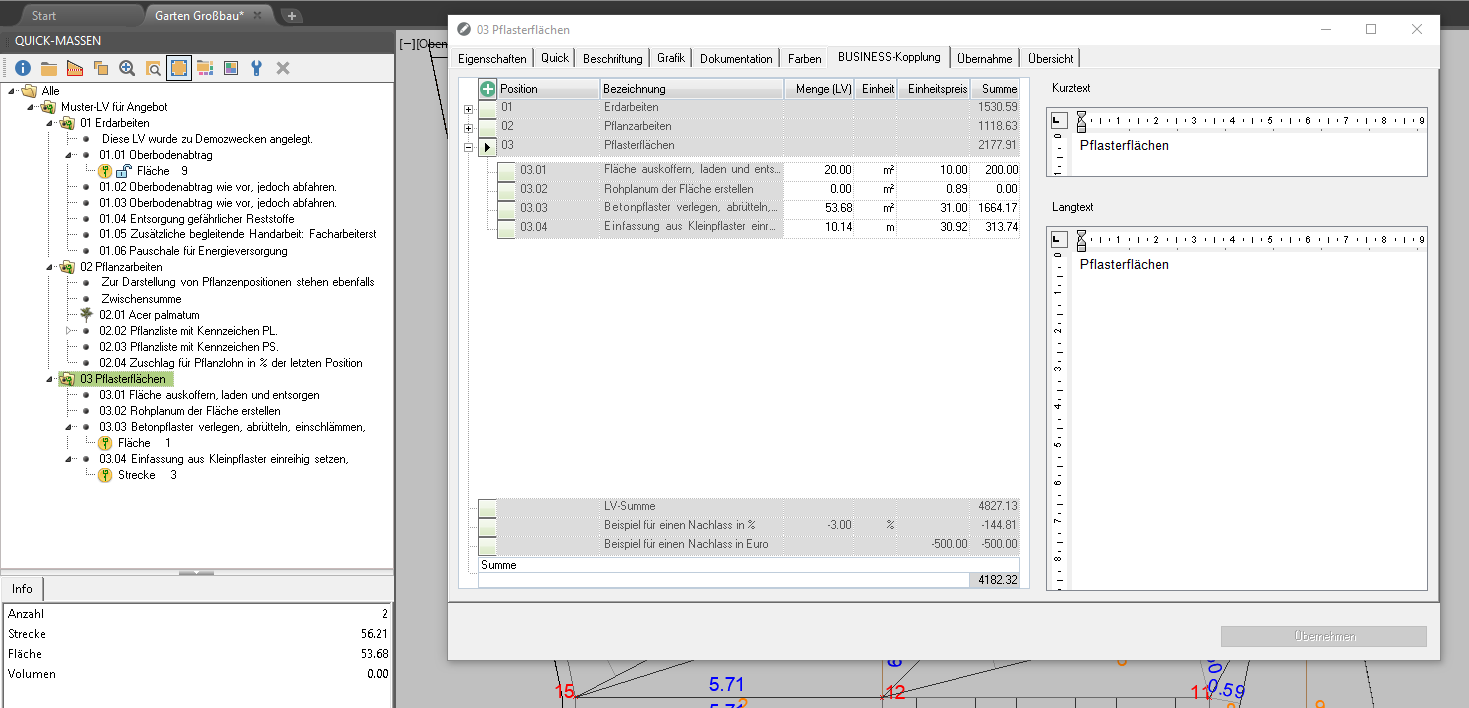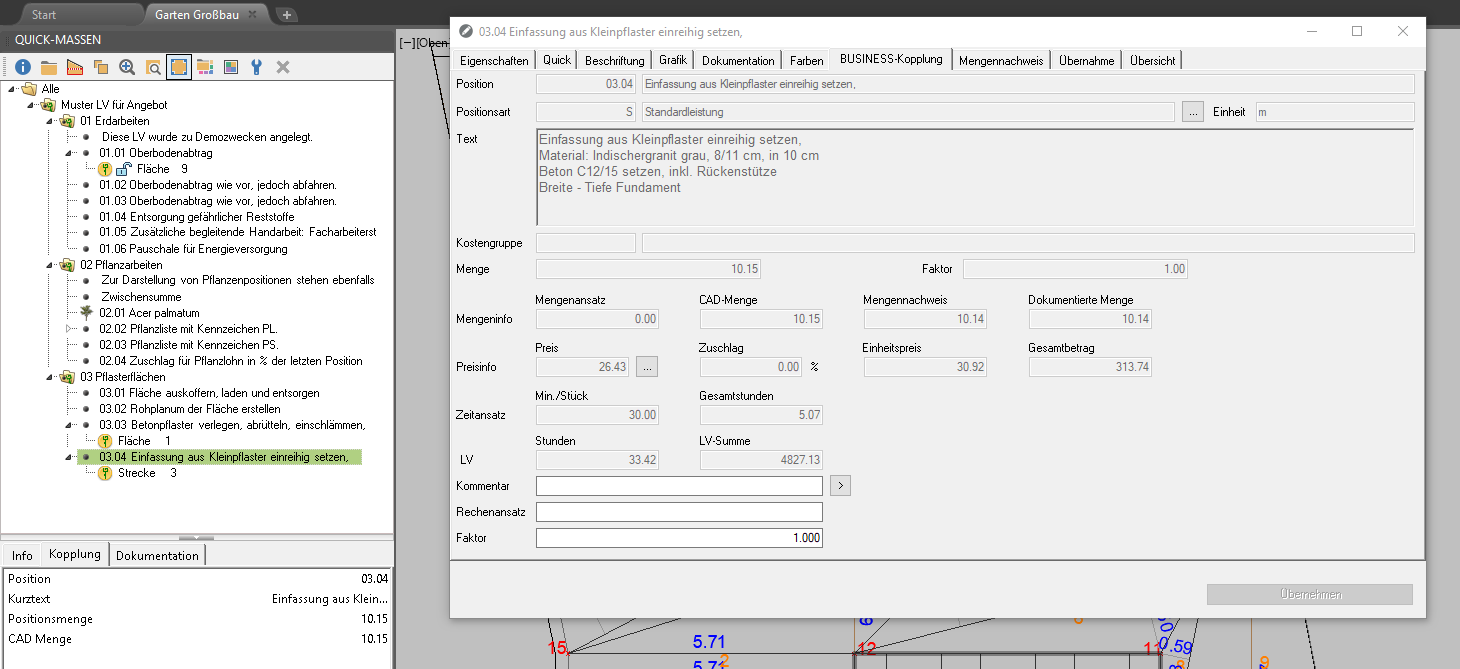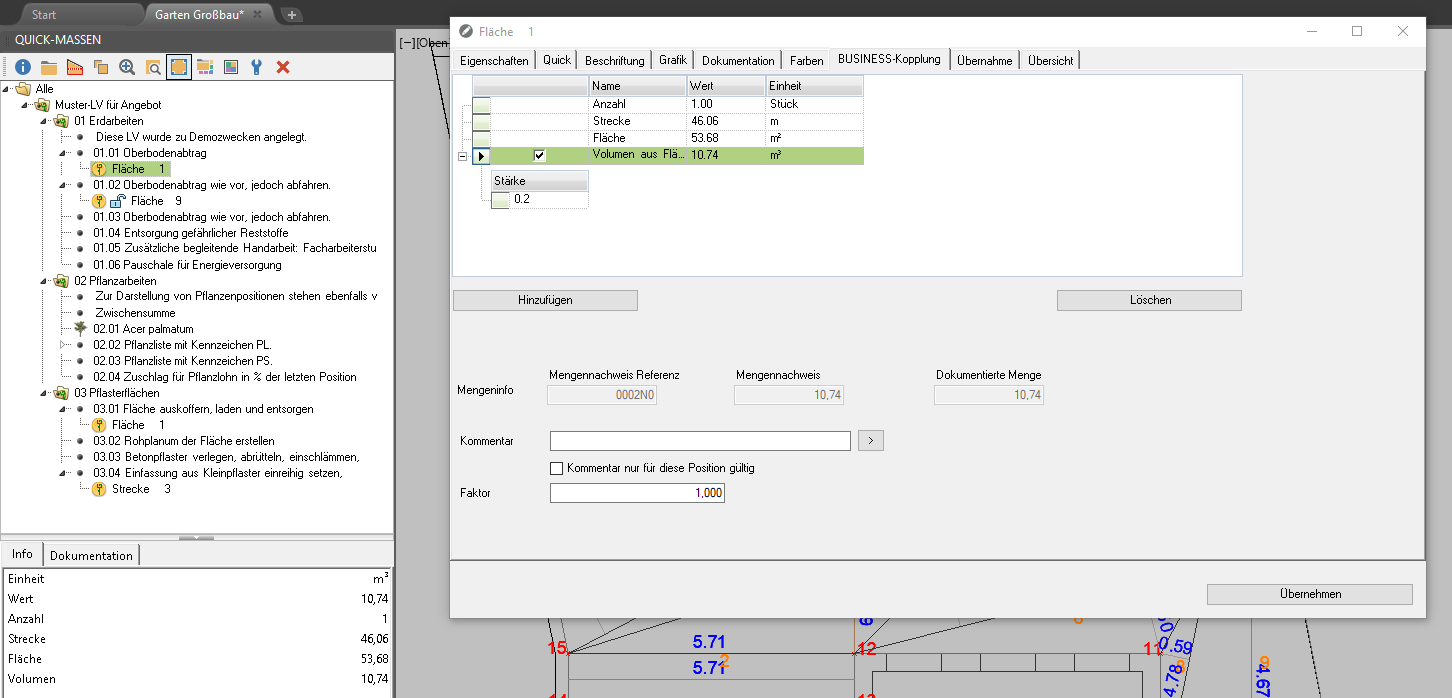Table of Contents
LV objects
Description
As soon as a hierarchy object is marked in the mass tree, a new tab with the name appears BUSINESS-Link. The hierarchy objects in the mass tree correspond to the structural levels (lot, title, section, etc.) in the specification of services or offer and have special properties.
Depending on the position in the mass tree, an overview of all contained positions and their different quantity fields is displayed. This overview can be used, for example, to determine whether all item quantities have been documented. The exact explanation of the quantity fields is given in chapter Position objects in the mass tree (see below).
See also the film: Position processing in CAD
Top hierarchy object in the mass tree
The top hierarchy object corresponds to the specification of services or offer and has special properties. As soon as the top hierarchy object in the Mass tree is highlighted, a new tab appears BUSINESS-Link.
Detailed information on the specification of services or the offer is displayed here. If active in DATAflor BUSINESS and DATAflor CAD is worked with [Update course] the mass tree from the database can be updated immediately. New positions are created automatically and all other information is updated.
Under Mass list is, if a quantity certificate has already been written and the LV has been updated, which is in BUSINESS active quantity verification displayed. Here you can see the history ![]() view the activities in the quantity statement. In addition, the quantity verification can be done with the function
view the activities in the quantity statement. In addition, the quantity verification can be done with the function ![]() straight from DATAflor CAD to be printed.
straight from DATAflor CAD to be printed.
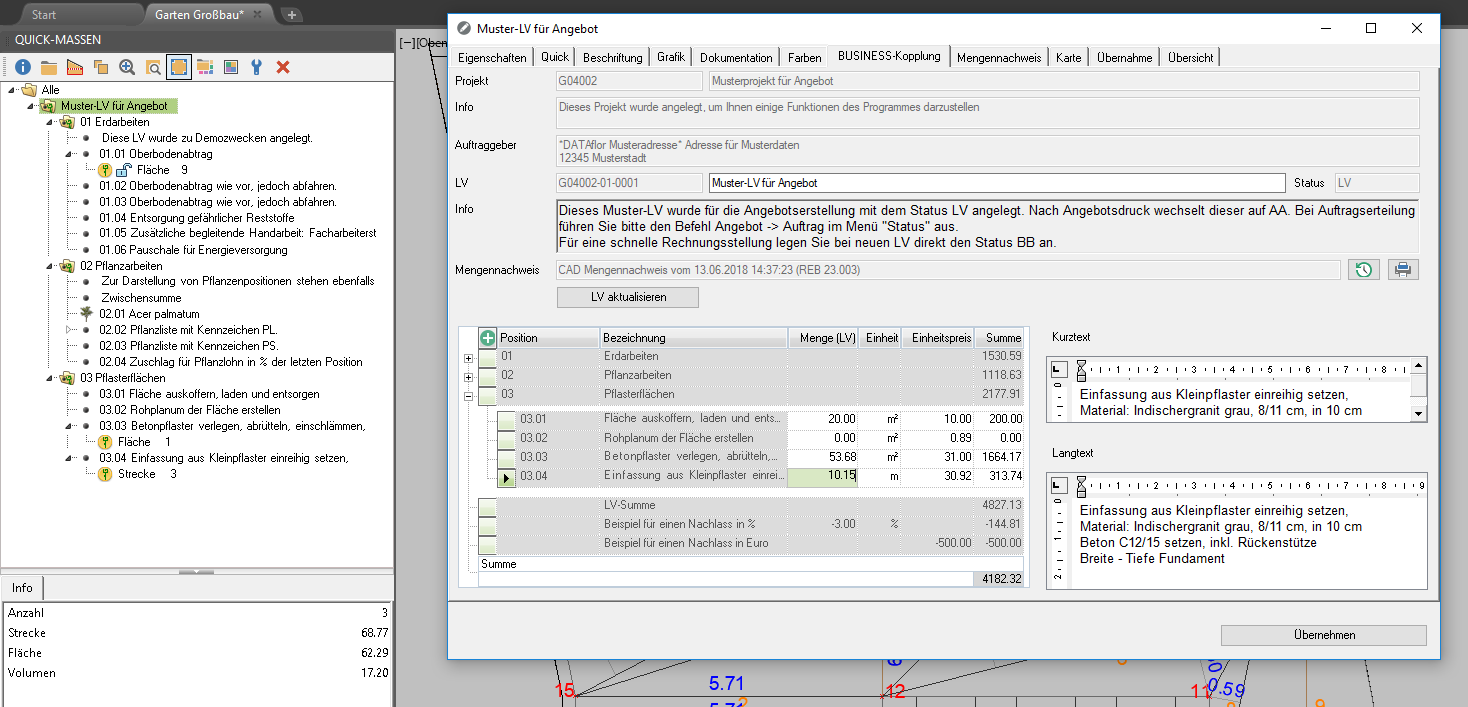
In the lower area, all positions from the course as in DATAflor BUSINESS displayed in a table. The table layout can be adjusted using the plus symbol. If an item is marked, entries (with a white background), such as the unit of measure, can be changed. In addition, LV designation, Short text and Long text edit and into the DATAflor BUSINESS [Take over].
Title in the mass tree
As on the course level, all positions from the course as in DATAflor BUSINESS displayed in a table. The table layout can be adjusted using the plus symbol. If an item is marked, entries (with a white background), such as the unit price, can be changed. In addition, LV designation, Short text and Long text edit and into the DATAflor BUSINESS [Take over].
Position objects in the mass tree
The position objects correspond to the positions in the specification of services or offer and have special properties. As soon as a position object is marked in the mass tree, the tab changes BUSINESS-Link.
All details about the position are displayed here. All fields are taken from the DATAflor BUSINESS Read out database. In some cases it may be necessary to DATAflor BUSINESS started and the specification of services is recalculated so that the entries generated by CAD are updated in the database. Then show the fields in the tab BUSINESS-Link the current values. May have to [Update course] activated at the level of the top hierarchy object so that the database entries can be read in again.
The meanings of the quantity fields are explained below:
| Quantity | Specifies the item quantity. This can be filled by CAD if the setting in the LV basic data CAD quantity = item quantity activated. The value can be added up by linking several drawings. |
| Quantity approach | Goes directly in DATAflor BUSINESS and is used for billing construction projects and for accounting (formerly estimated quantity). |
| CAD amount of the drawing | Specifies the determined set of child objects that are assigned to the position. |
| Mass list | Returns the documented amount in DATAflor BUSINESS Proof of quantity. The value can be added up through the coupling of several drawings as well as through manual entries in the quantity statement. |
| Documented amount of drawing | Indicates the documented set of child objects of the position. This value is determined using the REB calculation formulas. Initially, the value is not related to the DATAflor BUSINESS Proof of quantity. Only when the button is activated [Proof of quantity] in the tab Quick the entries are written in the quantity statement. |
In addition to the familiar display and input fields, the position objects also offer input options for Comments, Calculation approach and factor. All entries refer exclusively to the entry in the quantity statement.

| Comment | The comment is used to explain the quantity statement and is entered in the first place in the quantity statement with free text entry (formula 99 REB 23.003). The input can be freely or with predefined text modules via [>] take place (e.g. position from supplement). |
| Calculation approach | In special cases there is no drawing object for documentation or there is an increase in quantity with a fixed size (eg 550 m²). Using the calculation approach, simple calculations can be entered, which are then entered as a free calculation formula (formula 91 REB 23.003) in the quantity statement, e.g. 550+ (420 * 20) |
| factor | The factor corresponds to the input option factor in the quantity statement. This can be used, for example, to increase quantities (factor 1.1 = + 10% surcharge or factor 3 = documented quantity was used 3 times). Factors of subordinate objects (if entered) and the factor of the position are added up. |
Manage comments
The management (creating, editing, deleting and sorting) of comments takes place in the dialog Manage text modules and will over [>] called.

The first 10 entries can be inserted directly with [>] ready. With the function [Up] or [Downward] in the dialogue Manage text modules the most frequently used text modules can be moved to the upper area.
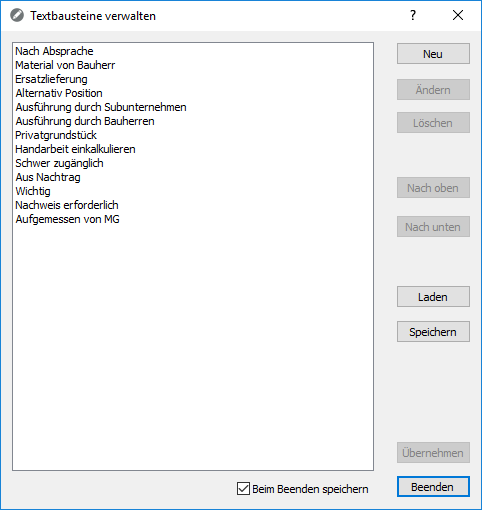
The call New line creates the entry % NZ%, this is a line break, ie a new comment line is started in the quantity list.
Objects below position objects
The tab changes for assigned objects BUSINESS-Link.
The properties of the object are displayed in the upper area. In addition to the properties that are derived from the object when it is recorded (usually number, distance and area), [Add] own or predefined formulas can be inserted. The results of a formula calculation are saved as attributes for the object. More information about the [Add] can be found in the chapters below.
If there is more than one property with the corresponding unit of measure, you can select which of the two quantities is to be transferred. If the box is deactivated save Handing over.

In addition to the fields for quantity information, there are also input options for the objects below items Comment and factor. All entries refer exclusively to the entry in the quantity statement.
| Comment | The comment serves as an explanation within the quantity verification and is entered directly before the entry of the quantity lines of this object with the free text input (formula 99). It is thus possible to provide individual objects with different comments within a position. The use and management of comments is explained for the position objects (see above Position objects in the mass tree). |
| factor | The factor corresponds to the input option factor in the quantity statement. This can be used, for example, to increase quantities (factor 1.1 = + 10% surcharge or factor 3 = documented quantity was used 3 times). A factor entered here is added up with the factor of the position (if entered). |
There is also the option Comment only valid for this position. This is a presetting if the object is to be copied in the mass tree. If the option is deactivated (default setting), the object + comment is copied.
Assignment of objects to positions
The assignment of objects to positions works in the same way as the normal recording of objects. A unit of measure for the item is determined and the corresponding object property is automatically used as the coupling quantity. In special cases, however, there may be no corresponding object property for the unit of measure for the item. In these cases, one of the following dialogues appears:



You can enter the corresponding values in this dialog. A conversion formula is automatically created for the recorded object.
If you do not want to have the object property converted automatically, for example because you want to work with your own formulas, you can click [Abort] click. The following message appears again.
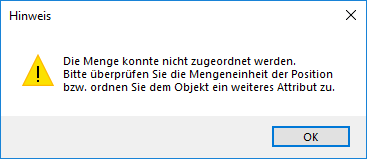
To assign the missing object properties to an object later, use Function [Add] on the tab BUSINESS-Link (see following chapters).
Areas from routes
In order to document an area from a route, the route must be marked. On the tab BUSINESS-Link will with [Add] the option Area from route offered.
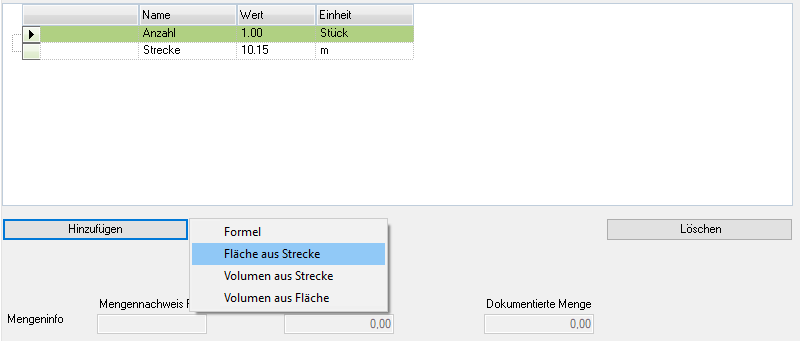
After the selection you will be asked for the Widthwhich can also be changed later.
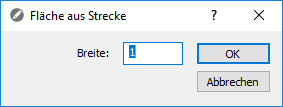
The derived area (Attribute Area from route) is now listed in the properties table and adopted as the quantity for the item. Documentation with REB Formula 91 (distance [10,15] x width [1,2]) is provided in the proof of quantity.

To change the width later, the attribute Area from route can be opened via the plus symbol in the properties table. Then the value Width to change. Other formulas can be used as long as the unit of the formula is also m².
An assignment of this automated formula directly to hierarchy objects (e.g. item level) is on the tab Features is possible.
Volume from distance
In order to document a volume from a route, the route must be marked. On the tab BUSINESS-Link is under [Add] the option Volume from distance offered.
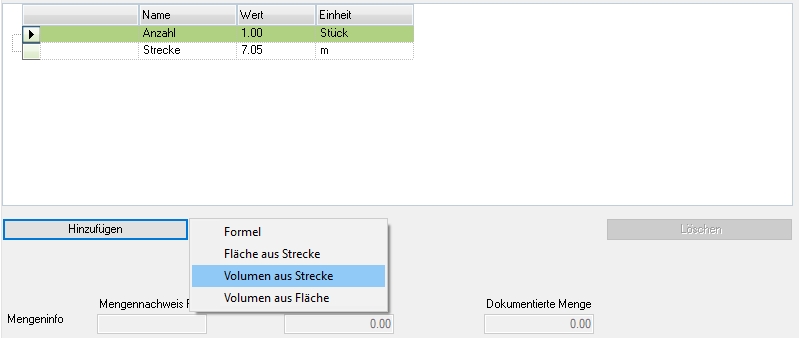
After the selection you will be asked for the Width and the Layer thicknesswhich can also be changed later.
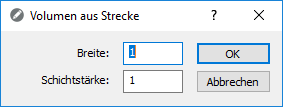
The derived volume (Attribute Volume from distance) is now listed in the properties table and adopted as the quantity for the item. Documentation with REB Formula 04 (cuboid) is provided in the quantity verification.

To change the width and the layer thickness later, the attribute Volume from distance can be opened via the plus symbol in the properties table. Then the values Width and Size . change
Furthermore, other formulas can also be used, provided that the unit of the formula is also m³.
An assignment of this automated formula directly to hierarchy objects (e.g. item level) is on the tab Features is possible.
Volume from surfaces
In order to document a volume from an area, the area must be marked. On the tab BUSINESS-Link is under [Add] the option Volume from area offered.
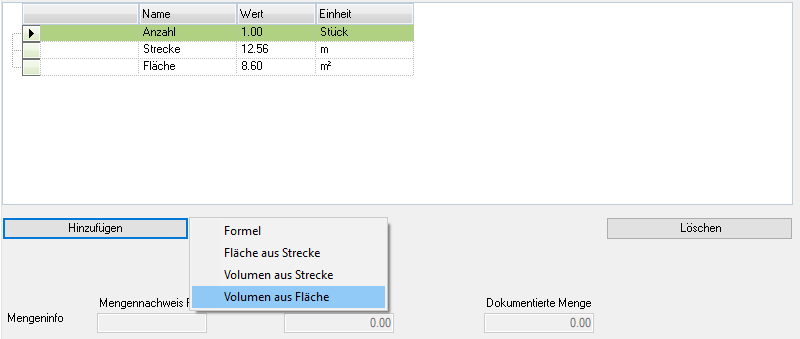
After the selection you will be asked for the Layer thicknesswhich can also be changed later.
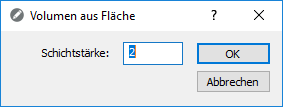
The derived volume (Attribute Volume from area) is now listed in the properties table and adopted as the quantity for the item. In the proof of quantity, documentation is provided with REB Formula 04 (cuboid) or Formula 01 (prism).

To change the layer thickness later, the attribute Volume from area can be opened via the plus symbol in the properties table. Then the value Size . change
Furthermore, other formulas can also be used, provided that the unit of the formula is also m³.
An assignment of this automated formula directly to hierarchy objects (e.g. item level) is on the tab Features is possible.
Other position units
With the help of formulas, the quantity can be determined for each item, regardless of which unit is present. For these cases, a formula must be created that has the item unit as the unit. On the tab BUSINESS-Link will with [Add] the option Formula offered.
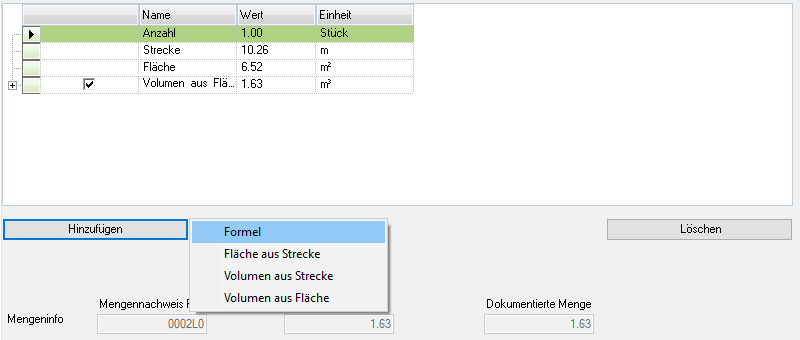
The creation and management of formulas is explained in the following chapter: Add attribute.
For some position units are from DATAflor also predefined formulas (e.g. weight from areas in tons / unit: t)
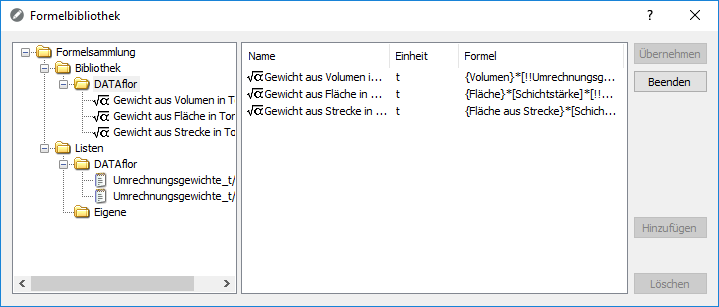
DATAflor CAD uses a conversion table (file UNITS.TBL). This simplifies the handling of units enormously, as different spellings and conversions are preset. Is as a position unit, for example M3 or cm3 entered, used DATAflor CAD automatically the m³ Quantity. If a unit is not recognized, the conversion table with a Editor can be added or changed.
Example of routes
